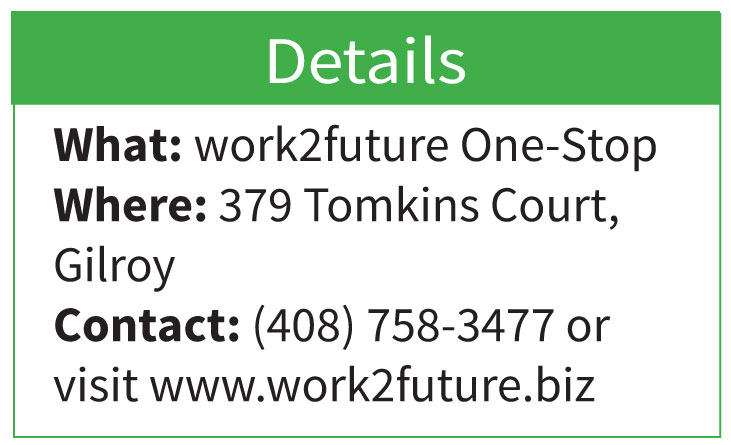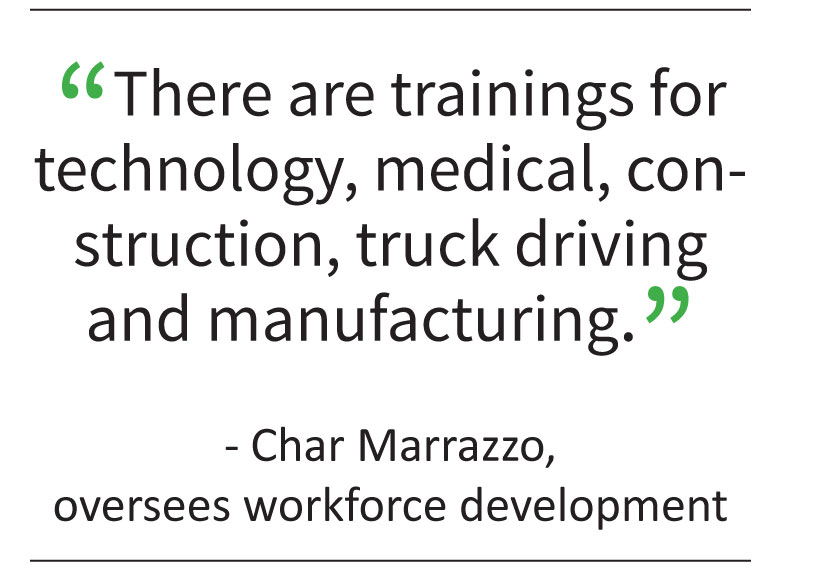Nonprofit trains people to find better jobs, helps employers find workers
Published in the January 16 – 29, 2019 issue of Morgan Hill Life

Photo by Robert Airoldi
Char Marrazzo, left, who oversees workforce development, with co-workers Mayra Clemente and Marta Bercera.
Many people find themselves stuck in undesirable jobs because they don’t have the time or the financial resources to pursue training that would elevate their career skills. At the same time, many employers want to hire more qualified candidates but struggle to find them. The nonprofit work2future assists job seekers — as well as employers — to create a more capable workforce in South Valley.
Char Marrazzo oversees workforce development at work2future’s Gilroy location. “The bottom line is we try to help and train people to find better jobs, and help employers hire and retain better workers,” she said. “It’s such a cool program.”
The nonprofit serves as the local administrative arm of the Workforce Innovation and Opportunity Act (WIOA). Locally, it’s a bit of a secret and Marrazzo hopes more people will find out about the programs it has to offer taken advantage to build their careers.
The nonprofit operates America’s Job Center of California One-Stops in Gilroy, Morgan Hill and San Jose. They serve several cities and unincorporated areas of Santa Clara County, including Gilroy and Morgan Hill. The Department of Labor is the main funding stream for centers. This comprehensive, federally-funded program is designed to strengthen and improve the public workforce system and help Americans, including youth 18 to 24 with significant barriers, find high-quality careers and help employers hire and retain skilled workers.
 Applicants come in, attend orientation and at the conclusion, are given an appointment to meet one-one with a career coach, and talk about goals, strengths and weaknesses, Marrazzo said.
Applicants come in, attend orientation and at the conclusion, are given an appointment to meet one-one with a career coach, and talk about goals, strengths and weaknesses, Marrazzo said.
“Maybe they need help with math,” she said. “Or some people are terrible with interviews and clam up. We take you where you are, work through your issues, and figure out the best plan.”
Opening it up to most South Valley adults, all the work2future programs are free and available to anyone 18 years or older who is eligible to work in the U. S.
“The most exciting part is that once every three years, the applicant can receive up to $6,000 toward occupational training,” Marrazzo said.
That funding eliminates the worry many people have about how to pay for schooling while still working another job to cover the rent and fill the refrigerator, she said.
 Applicants can attend educational workshops, learn how to get through the interview process, get some help polishing their resume, and learn beneficial skills like Excel spreadsheets, all so that they can move up in their career path. Through the WIOA, work2future offers more than 100 paid trainings. Some of the classes are offered at Gavilan and De Anza community college plus other trade or vocational schools, all recognized industry leaders.
Applicants can attend educational workshops, learn how to get through the interview process, get some help polishing their resume, and learn beneficial skills like Excel spreadsheets, all so that they can move up in their career path. Through the WIOA, work2future offers more than 100 paid trainings. Some of the classes are offered at Gavilan and De Anza community college plus other trade or vocational schools, all recognized industry leaders.
“There are trainings for technology, medical, construction, finance, and manufacturing,” Marrazzo said, naming only a few. “You could become a vet tech or medical assistant and earn your certification. And most of these positions fall into that $6,000 price range. College students can gain experience in their chosen field while going to school. This is a big advantage. Imagine how powerful that is for an individual.”
The nonprofit is just as beneficial for employers, too.
“The story gets better,” Marrazzo said. “We can go to an employer and offer them this training. Then they can send their employees to workshops to improve their skills. Employers retain their employees. Employees become more valuable. Everyone wins.” There are some circumstances where we can assist employers in the cost of on the job training.
In most cases, work2future can reimburse certain expense during training, such as the costs of equipment, clothing, and tools. For example, medical assistants need scrubs, and construction workers need tools. Those are costs that work2future may be able to cover.
After the initial orientation, applicants meet with a career coach for a one-on-one session. Another session is scheduled to discuss strategies. Afterward, training details are hammered out. Marrazzo advised that applicants do their homework and visit schools first. “Do your research,” she said. “Call the school, interview people already doing that job, and ask yourself if this is what you really want.”
The agency can offer educational workshops for corporate employees, find candidates, and provide occupational training — all at no cost to the employer. This allows businesses to improve their workforce without the headache and time commitment involved with recruiting and attending job fairs. In turn, employers gain access to qualified candidates who already know the basics of a job and are likely willing to learn new skills. The result is an improved workforce, all while benefitting the local economy.
And if things aren’t quite the perfect fit, that’s not a problem.
“We take initiative on the client’s part and follow you through the process for a year,” Marrazzo said. “We’ll support you. We want you to be successful.”






